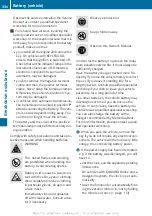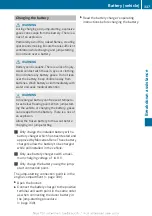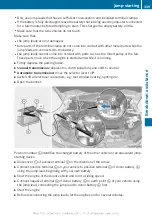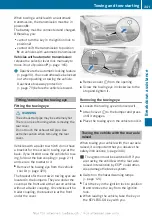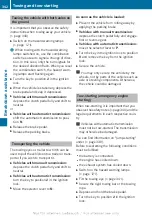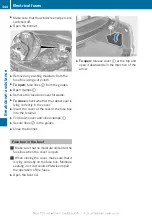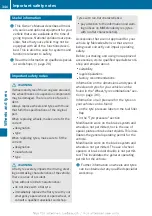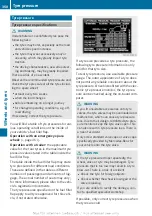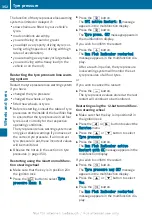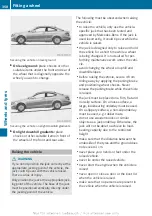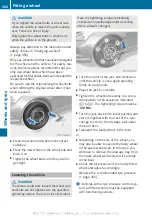
Tyre pressure
Tyre pressure specifications
G
WARNING
Underinflated or overinflated tyres pose the
following risks:
R
the tyres may burst, especially as the load
and vehicle speed increase.
R
the tyres may wear excessively and/or
unevenly, which may greatly impair tyre
traction.
R
the driving characteristics, as well as steer-
ing and braking, may be greatly impaired.
There is a risk of an accident.
Observe the recommended tyre pressure and
check the tyre pressure of all the tyres includ-
ing the spare wheel:
R
at least every two weeks
R
when the load changes
R
before embarking on a longer journey
R
for changed operating conditions, e.g. off-
road driving
If necessary, correct the tyre pressure.
You will find a table of tyre pressures for var-
ious operating conditions on the inside of
your vehicle's fuel filler flap.
Operation with an emergency spare
wheel: (
Operation with a trailer: the applicable
value for the rear tyres is the maximum tyre
pressure value stated in the table inside the
fuel filler flap.
The table inside the fuel filler flap may state
tyre pressures for different load conditions.
These are defined in the table as different
numbers of passengers and amounts of lug-
gage. The actual number of seats may vary;
for more information, please refer to the vehi-
cle's registration documents.
The tyre pressures specified on the fuel filler
flap apply to all tyres approved for this vehi-
cle, if not stated otherwise.
If a tyre size precedes a tyre pressure, the
following tyre pressure information is only
valid for that tyre size.
To test tyre pressure, use a suitable pressure
gauge. The outer appearance of a tyre does
not permit any reliable conclusion about the
tyre pressure. On vehicles fitted with the elec-
tronic tyre pressure monitor, the tyre pres-
sure can be checked using the on-board com-
puter.
G
WARNING
If you fit unsuitable accessories onto tyre
valves, the tyre valves may be overloaded and
malfunction, which can cause tyre pressure
loss. Due to their design, retrofitted tyre pres-
sure monitors keep the tyre valve open. This
can also result in tyre pressure loss. There is
a risk of accident.
Only screw standard valve caps or valve caps
specifically provided by Mercedes-Benz for
your vehicle onto the tyre valve.
G
WARNING
If the tyre pressure drops repeatedly, the
wheel, valve or tyre may be damaged. Tyre
pressure that is too low may result in a tyre
blow-out. There is a risk of accident.
R
Check the tyre for foreign objects.
R
Check whether the wheel is losing air or the
valve is leaking.
If you are unable to rectify the damage, con-
tact a qualified specialist workshop.
If possible, only correct tyre pressures when
the tyres are cold.
350
Tyre pressure
Wheels and tyres
Содержание 2013 C-Class Coupe
Страница 1: ...C Class Coupé Owner s Manual Nur für internen Gebrauch For internal use only ...
Страница 4: ......
Страница 32: ...30 ...
Страница 48: ...46 ...
Страница 83: ...Useful information 82 Key 82 Doors 88 Boot 91 Side windows 94 Sliding sunroof 98 81 Opening and closing ...
Страница 104: ...102 ...
Страница 294: ...292 ...
Страница 295: ...Useful information 294 Loading guidelines 294 Stowage areas 294 Features 299 293 Stowing and features ...
Страница 313: ...Useful information 312 ASSYST PLUS 312 Engine compartment 313 Care 319 311 Maintenance and care ...
Страница 328: ...326 ...
Страница 370: ...368 ...
Страница 386: ...384 ...

